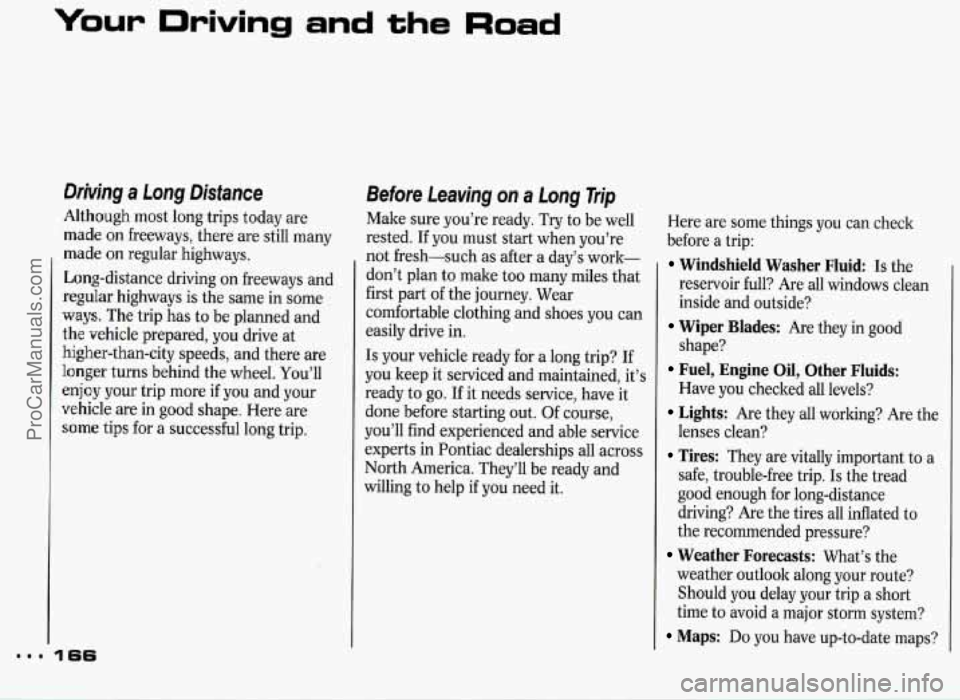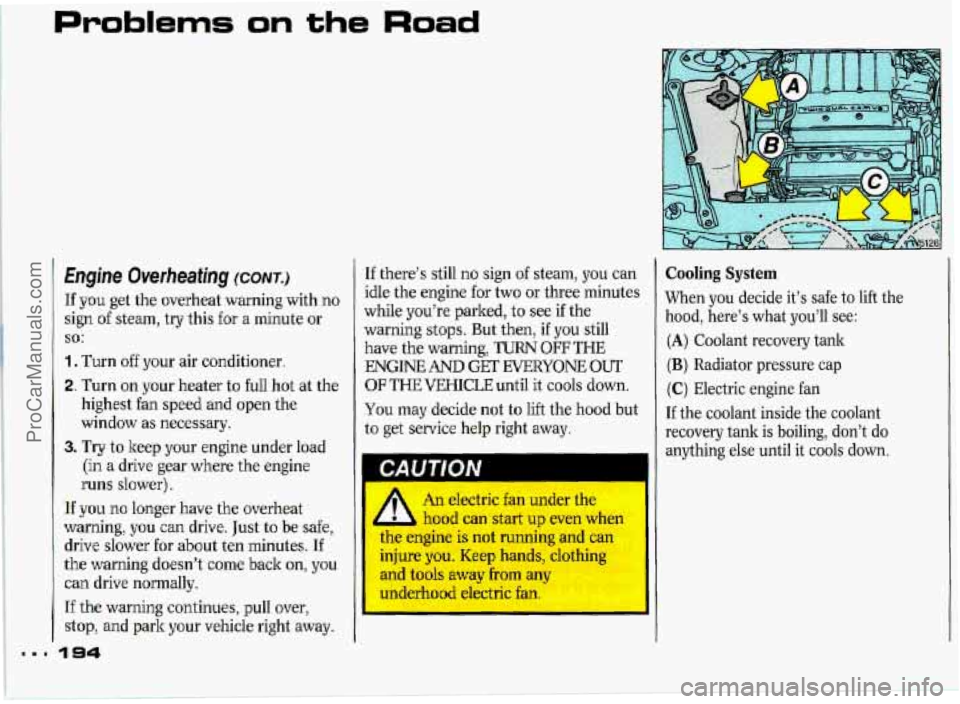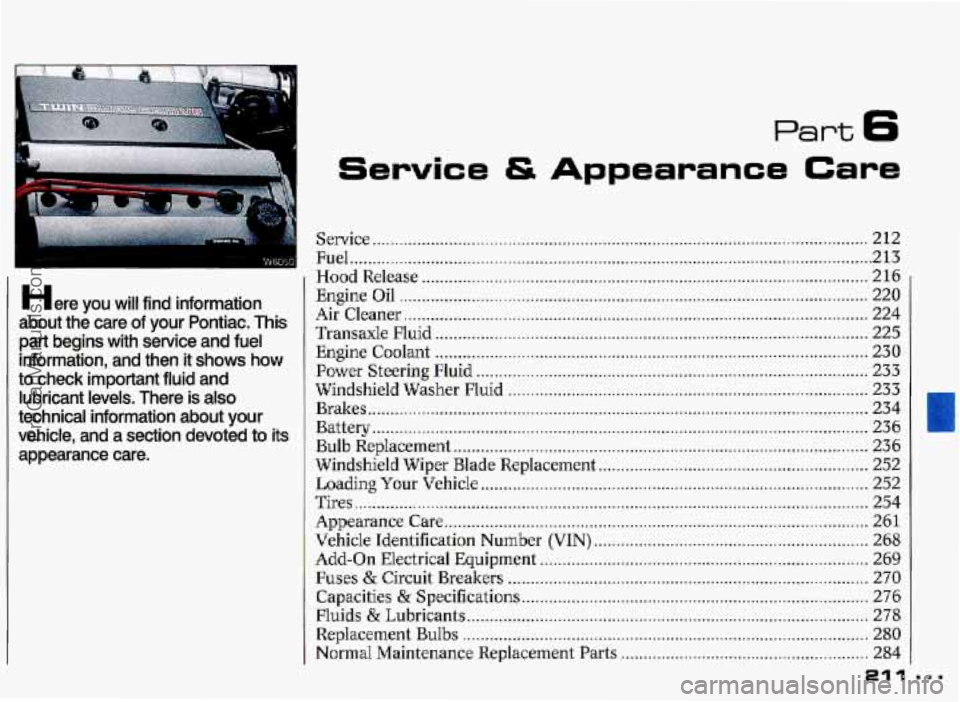1993 PONTIAC GRAND-PRIX oil
[x] Cancel search: oilPage 125 of 338

Comfo'rt Controls & Audio Systems
AMFM Stereo Radio with
Cassette Player
The digital display indicates information
on time or radio station frequency, the
AM ~k FM radio band, whether the
station
is in stereo, and other radio
functions.
V'OIL-BAL (Volume-Balance): Turn
the upper knob
to turn the radio on or
off, or to change volume. Press it to
change between the clock and the radio
statbn frequency display when the
radio is on. Press the knob to display
the time when the ignition is off.
The control ring behind the VOL-BAL
knob adjusts the lefthight speaker
balance.
TUNE-FADE: This knob has two
functions. Turn it to the left or right to
tune in radio stations (the radio station
frequency will be displayed on the
digital screen). Press this knob to
change between the
AM and FM bands.
The control ring behind the
TUNE
knob adjusts the fronthear speaker
balance.
TREBLE: Slide this lever up to
increase treble, or down to decrease it.
BASS: Slide this lever up to increase
bass, or down to decrease it.
SEEK: When you press SEEKA, you
will tune in the next station higher on
the radio band. When you press
YSEEK, you'll tune in the next station
lower.
When you press
SEEK A and V SEEK
at the same time, the radio will scan
the dial, pausing for a few seconds
at
each station. To select a station, press
both buttons again.
To Preset Radio Stations:
The four pushbuttons can be used to
preset up to
14 radio stations (seven
AM and seven FM).
1. Use the lower knob (TUNE) to tune
in the station you want.
2. Press SET. The SET indicator will
appear
on the digital screen for five
seconds.
3. While the SET indicator is displayed,
press one of the four pushbuttons.
The station you selected will be
automatically tuned whenever you
press this button again.
4. Repeat steps 1-3 for each of four AM
and four FM stations.
ProCarManuals.com
Page 135 of 338

Comfort Controls & Audio Systems
Care of Your Cassette Tape
Player
(CONT.)
Clean your tape player with a wiping-
action, non-abrasive cleaning cassette,
and follow the directions provided with
it.
Cassettes are subject to wear and the
sound quality may degrade over time.
Always make sure that the cassette tape
is
in good condition before you have
your tape player serviced.
Care of Your Compact Discs
Handle discs carefully. Store them in
their original cases or other protective
cases and away from direct sunlight and
dust. If the surface of a disc is soiled,
dampen a clean, soft cloth in a mild,
neutral detergent solution and clean it,
wiping from the center to the edge.
Be sure never to touch the signal
surface when handling discs. Pick up
discs by grasping the outer edges or the
edge of the hole and the outer edge.
Fixed Mast Antenna
The fixed mast antenna can withstand
most car washes without being
damaged.
If the mast should ever
become slightly bent,
you can straighten
it
out by hand. If the mast is badly bent,
as it might be by vandals, you should
replace it.
Check every once in a while to be sure
the mast is still tightened to the fender.
ProCarManuals.com
Page 167 of 338

Your Driving and the Road
Drkjng a Long Distance
Although most long trips today are
made on freeways, there are still many
made
on regular highways.
Long-distance driving on freeways and
reguIar highways is the same in some
ways. The trip has to be planned and
the vehicle prepared, you drive at
higher-than-city speeds, and there are
longer turns behind the wheel. You’ll
enjoy your trip more if you and your
vehicle are in good shape. Here are
some tips for a successful long trip.
Before Leaving on a Long Trip
Make sure you’re ready. Try to be well
rested. If you must start when you’re
not fresh-such as after a day’s work-
don’t plan to make too many miles that
first part of the journey. Wear
comfortable clothing and shoes you can
easily drive in.
Is your vehicle ready for a long trip? If
you keep it serviced and maintained, it’s
ready to go. If it needs service, have it
done before starting out. Of course,
you’ll find experienced and able service
experts in Pontiac dealerships all across
North America. They’ll be ready and
willing to help
if you need it. Here
are some things you can check
before a trip:
Windshield Washer Fluid Is the
reservoir full? Are all windows clean
inside and outside?
shape?
Have you checked all levels?
lenses clean? safe, trouble-free trip.
Is the tread
good enough for long-distance
driving? Are the tires all inflated to
the recommended pressure?
weather outlook along your route?
Should
you delay your trip a short
time to avoid a major storm system?
Maps: Do you have up-to-date maps?
Wiper Blades: Are they in good
Fuel, Engine Oil, Other Fluids:
Lights: Are they all working? Are the
Tires: They are vitally important to a
Weather Forecasts: What’s the
ProCarManuals.com
Page 182 of 338

Parking on Hills
You really should not park your vehicle,
with a trailer attached, on a hill.
If
something goes wrong, your rig could
start to move. People can be injured,
and both your vehicle and the trailer
can be damaged.
But if you ever have to park your rig on
a hill, here’s how to do it:
1. Apply your regular brakes, but don’t
shift into
P (Park) yet.
2. Have someone place chocks under
the trailer wheels.
3. When the wheel chocks are in place,
release the regular brakes until the
chocks absorb the load.
4. Reapply the regular brakes. Then
apply your parking brake, and then
shift to
P (Park).
5. Release the regular brakes.
When You Are Ready to Leave After
Parking
on a Hill
1. Apply your regular brakes and hold
the pedal down while you:
Start your engine;
Shift into a gear; and
Release the parking brake.
2. Let up on the brake pedal.
3. Drive slowly until the trailer is clear
4. Stop and have someone pick up and
of
the chocks.
store the choclts.
Maintenance When Trailer Towing
Your vehicle will need service more
often when you’re pulling a trailer. See
the Maintenance Schedule for more on
this. Things that are especially
important in trailer operation
are
automatic transaxle fluid (don’t
overfill), engine oil, belts, cooling
system, and brake adjustment. Each
of
these is covered in this manual, and the
Index will help you find them quickly. If
you’re trailering, it’s a good idea to
review these sections before you start
your trip.
Check periodically to see that all hitch
nuts and bolts are tight.
IBI ...
ProCarManuals.com
Page 195 of 338

Problems on the Road
Engine Overheafing ICONT.)
If you get the overheat warning with no
sign
of steam, try this for a minute or
1. Turn off your air conditioner.
2. Turn on your heater to full hot at the
SO:
highest fan speed and open the
window as necessary.
3. Try to keep your engine under load
(in a drive gear where the engine
runs slower).
If you no longer have the overheat
warning,
you can drive. Just to be safe,
drive slower for about ten minutes. If
the warning doesn’t come back
on, you
can drive normally.
If the warning continues, pull over, If
there’s still
no sign of steam, you can
idle
the engine for two or three minutes
while you’re parked, to
see if the
warning
stops. But then, if you still
have the warning,
TURN OFF THE
ENGINEANDGETEVERYONEOUT
OF THE IrEp3[1CLE until it cools down.
You may decide not to lift the hood but
to get servioe
help right away.
a
An electric fan under the
L L hood can start up even when
the engine
is not running and can
injure you. Keep hands, clothing
and tools away from any
underhood electric fan. I
stop, and park your vehicle right away. I I
Cooling System
When you decide it’s safe to lift the
hood, here’s what you’ll see:
(A) Coolant recovery tank
(B) Radiator pressure cap
(C) Electric engine fan
If the coolant inside the coolant
recovery tank is boiling, don’t do
anything else until it cools down.
ProCarManuals.com
Page 196 of 338

The coolant level should be at or above
the
COLD mark. If it isn’t, you may
have a leak in the radiator hoses, heater
hoses, radiator, water pump or
somewhere else in the cooling system.
~ CAUTION
A
Heater and radiator hoses,
and other
engine parts, can
be very hot. Don’t touch them. If
you do, you can be burned.
Don’$ run the engine if there is a
leak. If you run the engine, it could
lose all coolant. That could cause
an engine fire, and you could be
burned. Get any leak fixed before
I vou drive the vehicle.
If there seems to be no leak, check to
see if the electric engine fan is running.
If the engine is overheating, the fan
should be running. If it isn’t, your
vehicle needs service.
How to Add Coolant to the Coolant
Recovery Tank:
If you haven’t found a problem yet, but
the coolant level isn’t at or above
COLD, add a 50/50 mixture of clean
water (preferably distilled) and a proper
antifreeze at the coolant recovery tank.
(See the
Index under Engine Coolant
for more information about the proper
coolant mix.)
A
Adding only plain water to
your cooling system
can be
dangerous. Plain water,
or some I
other liquid like alcohol, can boil
before the proper coolant
mix will.
Your vehicle’s coolant warning
system
is set for the proper coolant
mix. With plain water or the wrong
mix, your engine could get too hot
but you wouldn’t get the overheat
warning. Your engine could catch
fire and
you or others could be
burned. Use a
50/50 mix of clean
water and a proper antifreeze.
cold weather, water can free-
d crack the engine, radiatnr
ater core and other parts.
ProCarManuals.com
Page 206 of 338

14. Remove any rust or dirt from the
wheel bolts, mounting surfaces or
spare wheel. Place the spare on the
wheel mounting surface.
--
, Never use oil or grease on I
studs or nuts. If you do, i 3
luts might come loose. Your wheel
.Id fall off, causing a seril 1
accident. I
15. Replace the wheel nuts with the
rounded end
of the nuts toward the
wheel. Tighten each nut by hand
until the wheel is held against the
hub.
16. Lower the vehicle by rotating the
wheel wrench countercloclwise.
Lower the jack completely.
205
u
ProCarManuals.com
Page 212 of 338

Part 6
Here you will find information
about the care
of your Pontiac . This
part begins with service
and fuel
information. and then it
shows how
to check important fluid and lubricant levels
. There is also
technical information about your
vehicle. and a section devoted
to its
appearance care
.
81 1
Service & Appearance Care
Service ........................................................................\
...................................... 212
Fuel ........................................................................\
............................................ 213
Hood Release ........................................................................\
............................ 216
Engine Oil
........................................................................\
................................ 220
Air Cleaner ........................................................................\
............................... 224
Transaxle
Fluid ........................................................................\
........................ 225
Engine Coolant ........................................................................\
........................ 230
Power Steering Fluid ........................................................................\
............... 233
Windshield Washer
Fluid ........................................................................\
........ 233
Brakes
.......... .......................... ........................................................................\
... 234
Battery
........................................................................\
........................ .... .......... 236
Bulb Replacement ........................................................................\
.................... 236
Loading
Your Vehicle ........................................................................\
.............. 252
Vehicle Identification Number (VIN) ............................................................. 268
Capacities
& Specifications ........................................................................\
..... 276
Replacement
Bulbs ................................................................... .......- ............... 280
Windshield Wiper
Blade Replacement ............................................................ 252
Tires ........................................................................\
.......................................... 254
Appearance Care ........................................................................\
...................... 261
Add-on Electrical Equipment ........................................................................\
. 269
Fuses & Circuit Breakers ........................................................................\
........ 270
Fluids
& Lubricants ........................................................................\
................. 278
Normal Maintenance Replacement Parts ....................................................... 284
ProCarManuals.com